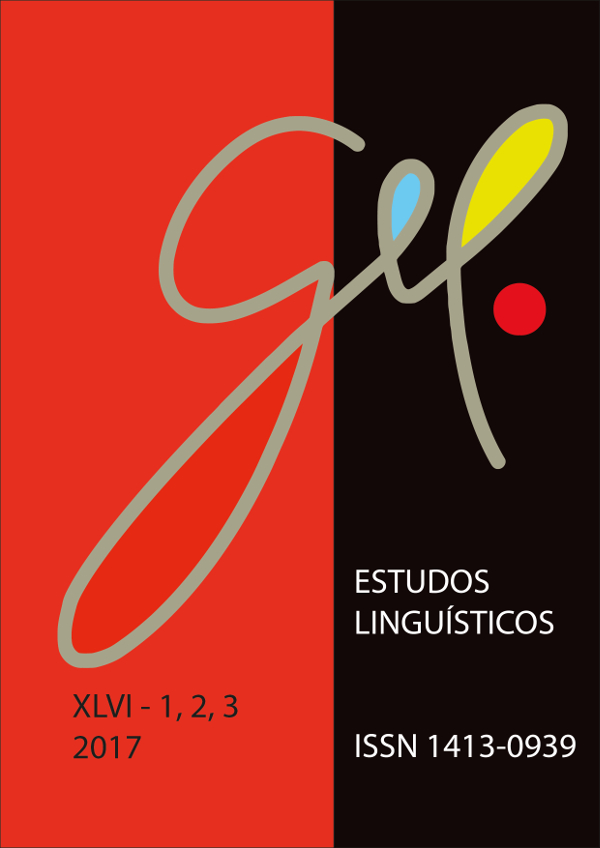Scientific-poetical bivocalism in a selection of poems, by Arnaldo Antunes
DOI:
https://doi.org/10.21165/el.v46i1.1538Keywords:
heteroglossia, Arnaldo Antunes, Bakhtin, Voloshnov, GuilbertAbstract
Arnaldo Antunes is known for combining lexical creations with vocal and graphic resources exploring through a kind of verbi-voco-visual language in James Joyce’s terms. The concrete poetry, the discursive genre selected by the author, exceed the limits of the creative forces drawn by Bakhtin as the centripetal force found in the poem and the centrifugal force observed in discursive fields, and the heteroglossia found in the novel, which allows problematizing the poet’s creative language that accesses the scientific field by a discursively responsive art. This article has as objectives studying the expressiveness in a selection of poems, by mapping the semantic and syntagmatic neologisms resulted from a new motivation and the use in new contexts, allied with the notion of ideological signs, as well as scrutinizing the discourses related to the ideological fields, by taking into account the verbi-voco-visual language.Downloads
References
ANTUNES, A. 2 ou + corpos no mesmo espaço. São Paulo: Ed. Perspectiva, 1997.
BAKHTIN, M. M. Estética da criação verbal. Tradução de Paulo Bezerra. 4. ed. São Paulo: Martins Fontes, 2011.
______. Teoria do romance I: A estilística. Rio de Janeiro: Editora 34, 2015 [1975].
BARBOSA, M. A. Léxico, produção e criatividade. São Paulo: Global editora, 1981.
CAMPOS, H. de. Ruptura dos Gêneros na Literatura Latino-Americana. São Paulo: Ed. Perspectiva, 1977.
CAMPOS, A. de; PIGNATARI, D.; CAMPOS, H. Mallarmé. São Paulo: Perspectiva, 1991.
CARDOSO, E. A. A criação neológica estilística. Matraga, Rio de Janeiro, v. 16, p. 105-118, 2004.
CARDOSO, E. A.; CONDÉ, V. G.; GIL, B. D. (Org.). Modelos de análise linguística. São Paulo: Contexto, 2009.
GRILLO, S. V. de C. Esfera e Campo. In: BRAIT, B. (Org.). Bakhtin: outros conceitos-chave. São Paulo: Contexto, 2006. p. 133-160.
______. Fundamentos bakhtinianos para a análise de enunciados verbo-visuais. Filologia linguística portuguesa, n. 14(2), p. 235-246, 2012.
GUILBERT, L. Théorie du néologisme: Communication de M. Louis Guilberï (Paris-Nanterre) au XXIVe Congrès de l'Association, le 24 juillet 1972.
HOUAISS, A.; VILLAR, M. de S.; FRANCO, F. M. de M. Dicionário Houaiss da língua portuguesa. Rio de Janeiro: Objetiva, 2009.
IGNEZ, A. F.; CARDOSO, E. de A. Escolhas lexicais: estilo e expressividade. In: MICHELETTI, G. Estudos de discurso e estilo. São Paulo: Terracota, 2012. p. 17-38.
MEDVIÉDEV, P. N. O método formal nos estudos literários: Introdução crítica a uma poética sociológica. São Paulo: Ed. Contexto, 2010.
PIGNATARI, D. O que é comunicação poética. São Paulo: Ateliê Editorial, 2005.
RAJEWSKY, I. O. Intermidialidade, intertextualidade e “remediação”: Uma perspectiva literária sobre a intermidialidade. In: DINIZ, T. F. N. Intermidialidade e Estudos interartes: Desafios da arte contemporânea. Belo Horizonte: Ed. UFMG, 2012. p. 15-45.
VOLOCHÍNOV, V. N.; BAKHTIN, M. M. Marxismo e filosofia da linguagem. Tradução de Michel Lahud e Yara Frateschi Vieira. São Paulo: Hucitec, 2012.



